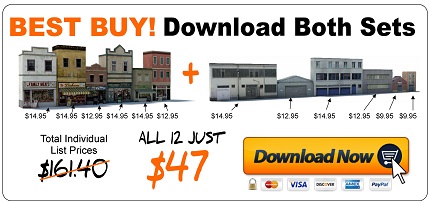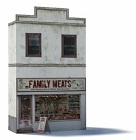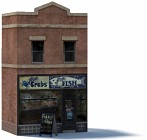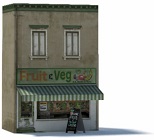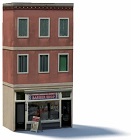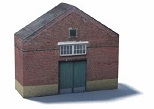- All O scale model buildings featured on this website are delivered by
download very quickly after you purchase. There is no waiting! No shipping to
pay!
- The buildings are "photo-realistic" in style so look more real than
plastic or painted structures.
- The download page gives you the choice to download the PDF files in A4 size (letter size),
and/or A3 size (tabloid size). You don't pay any extra for both options. Print A4 on your home
printer (the joins are almost invisible), or print full size (no joins) by taking the file into
your local fast copy print shop. The files are small so will easily fit on a removal USB memory
stick.
- We recommended constructing the O scale model buildings using foam board, corflute,
plywood, or cardboard (materials not included). Corflute and foam is the most popular option
with modelers, because it is SUPER STRONG, CHEAP TO BUY IN A BIG
SHEET and is EASILY CUT WITH AN X-ACTO KNIFE!
- The corflute (or other material) is then cut to the required shape (using a sharp craft
knife). The printed design is then glued to the corflute taking care to remove air pockets
(roll it with a bottle, rolling pin, or metal ruler).
- The front, sides and roof can then be glued together using the flaps that come with the
plans. Clothes pins (pegs) are ideal for securing parts together while they dry. Clear glue, a
glue stick, or spray-on adhesive are all suitable.
- All designs on this website have a 60-day, money-back guarantee.
Buy Special 6 Shop Deal (Save 65%)
$29.95 Buy Special 6 Warehouse Deal (Save 60%)
$29.95
BEST BUY - Download Both Sets - Shop Deal and
Warehouse Deal ONLY $47.00
How to Make Low Cost Real Looking
Background Buildings for a Model Railroad Backdrop
Article from hobbyist Kevin C
Along the back of the layout there may not be much room to put in a complete building. Some use
it as an industrial area or a railroad station with a town on a back drop glued to the wall giving
the viewer the impression that the layout continues into the distance. However just painting the
scene on the wall does not really give it the 3D effect and it always looks flat, so to overcome
this, using low profile buildings does give the viewer the desired 3D effect.
On my layout there is a flat top hill against the wall behind the station and I wanted to put in
a plastic model of a hotel, but I did not have room for the complete model so I cut it down on the
sides so that it was now about 3/4 inch thick and it fitted perfectly on the hill overlooking the
station. Of course you don't have to go the extreme of half destroying a perfectly good model.
Amongst the model buildings that I downloaded there were some low relief buildings as an
industrial area, a warehouse area, some shops and houses. These are made of cardboard or you can
use foam core board which will make the building a lot stronger.
How to strengthen railroad buildings
This time I used Foam core board like that used on real estate signs. This is easy to use and
assemble and can be glued with PVA glue but it will take longer for the glue to dry. Clear glue ($1
- $2 a tube) is much quicker drying and dry very strong.
First off I had very limited space and cut the profile down to half the printed size as I need
to have a road way in front of the shops on the top of the hill. I glued the printed design to thin
card except I carefully removed each edge wall except the ones at each end.
After gluing the fronts on and matching them, I cut the foam board to size and glued the fronts
in position and left it to dry. I cut the pieces of the building edges and glued them in position
where the building was taller than the side of the next shop and then glued the roof sections on.
All this took awhile as we waited for the glue to dry, but once done we had a good strong
building.
The good thing about building like this is that you can print out another copy if you make a
mistake, whereas if you make a mistake with a plastic building you either live with it or fork out
to buy another model.
I glued in a piece of 9mm MDF on the inside of the building to add additional strength. I left
this to dry with weights on top (I used water bottles filled with water) and this worked well. Now
the building is ready to put in place on the layout. By gluing it to the wall and I formed a road
in front of the buildings I then put people in place and had them looking in the shop windows and
walking along the footpath. I added a couple of parked vehicles to complete the scene.
How to make a loading dock
If you choose to use the commercial warehouse low profile building you could add loading docks
and railroad sidings so that boxcars can be parked there along with workers loading and unloading
also trucks bringing in supplies etc.
With the use of balsa wood sheet you can fill in between the tracks so vehicles can be added to
the scene. The balsa wood once cut to size and sanded to less than 2mm and by painting and adding
earth colored scatter material and using weathering techniques to add oil stain between the rails
is glued in place. For those using inches (4mm = 0.16" = 4 / 25"). I use 4 mm MDF in the larger
space between the tracks with a rebated edge to cover over the ties (sleepers) at the edge of the
track. Whether you are using steam or diesel engines the oil stain would be the same to add
realism.

On the second build I decided to make up the industrial area and I used 20mm MDF and marked out the
roof line and angles after allowing sufficient board for the entire project. I cut the angles for
the roof sections by setting my jigsaw to the correct angle and carefully cut out the shape. I
clamped a straight edge to the MDF so that the saw would cut in a dead straight line, moving the
straight edge to correspond with the different roof heights.
Then after sanding smooth I was able to glue the printout directly to the MDF and on one
warehouse I cut out the door size in the MDF and cut a grove on each side of the door opening with
a small hand saw and cut a turn at the top with my Dremel rotary tool to allow the door to bend at
the top to represent the open door.
I printed a second page with the door on it to a larger scale and then glued to cardboard. The
door was cut to size to fit in the groove and glued in place, and cut the excess from the top so
that the MDF would still mount
to the wall. I will paint the wall to represent the inside of the warehouse and paint different
freight on pallets spaced around the inside walls. I glued a figure to look as though he was
directing a truck in the doorway and placed a flat deck truck in the doorway with more freight on
its deck that would be unloaded.

ClickBank is the retailer of products on this site. CLICKBANK® is a registered
trademark of Click Sales Inc., a Delaware corporation located at 1444 S. Entertainment Ave., Suite
410 Boise, ID 83709, USA and used by permission. ClickBank's role as retailer does not constitute
an endorsement, approval or review of these products or any claim, statement or opinion used in
promotion of these products.
|

